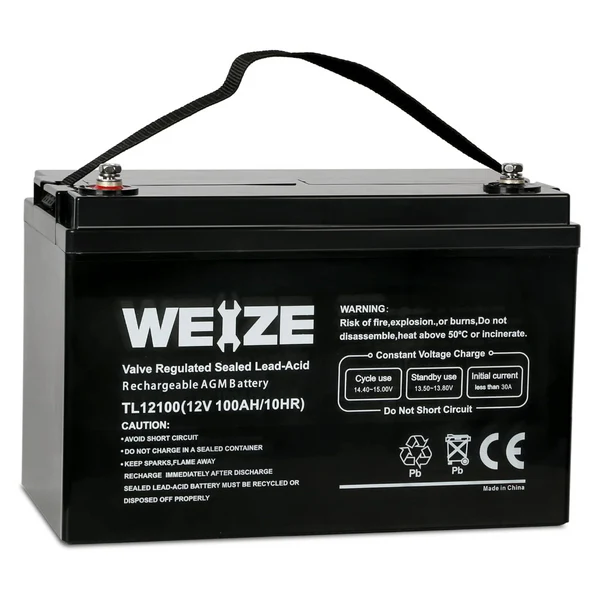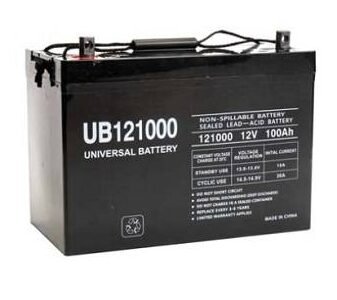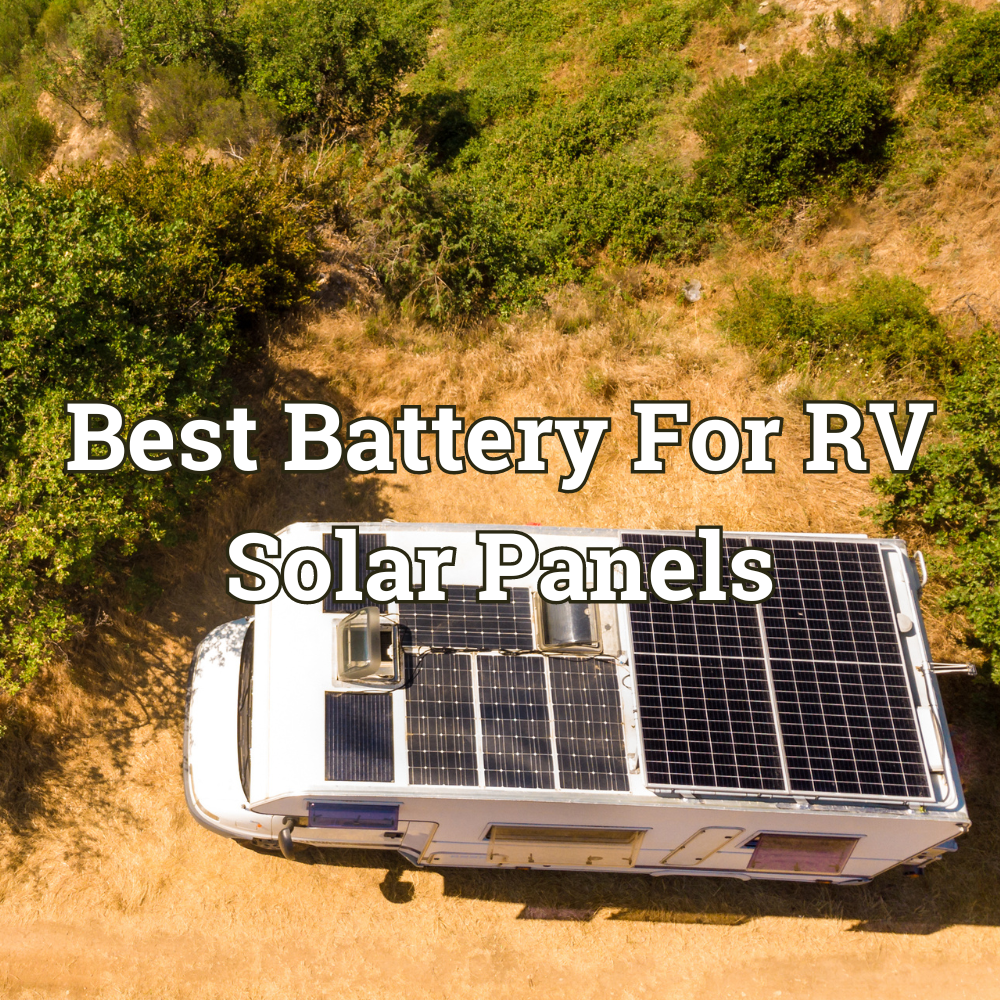Ok, here we’re going to take a look at some of the best RV deep cycle batteries.
The batteries listed here are recommendations from myself, seasoned RVers, and full time van life folks.
My personal choice would be the SOK 12V 100ah lithium battery.
As well as my choices of battery, I’ve put together a few simple guides on battery types, sizing a battery for your power needs, understanding amp hours and watts, and battery maintenance.
Contents (Quick Links)
🏆 Best Overall
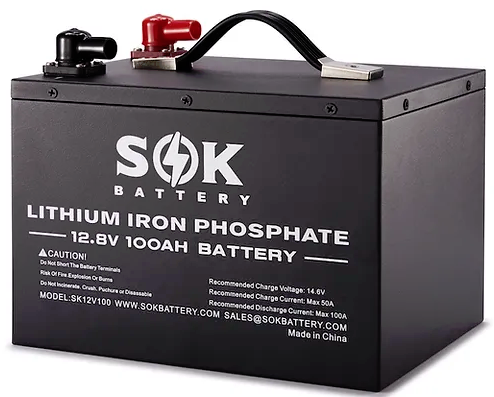

Best RV Deep Cycle Batteries
- Sok Lithium 12V 100Ah – Best Overall
- Battleborn 12V 100Ah – 2nd Choice Lithium
- LiTime Lithium 12V 100Ah – Best Budget Lithium
- Renogy AGM 12V 100Ah – Best AGM
- Weize AGM 12V 100Ah – 2nd Choice AGM
- UPG Universal AGM 12V 100Ah – Best Budget AGM
Here’s a more detailed look at what I consider to be the best RV deep cycle batteries.
Sok Lithium 12V 100Ah
⭐️Best Overall
The SOK lithium battery is my top pick for anyone looking for a solid, affordable option. For the price, the Sok battery’s build quality is exceptional.
You can connect up to 4 batteries in series or 10 in parallel, giving you plenty of flexibility depending on your energy needs.
What really sets the Sok apart is that it’s fully serviceable. You can pop off the lid to access the individual cells and the BMS (which is also made by SOK). Although problems are rare, the BMS is replaceable. The Sok BMS is of excellent quality, and does a great job protecting the battery from overcharging, discharging, and low temperatures.
A major plus is the SOK Battery app, which lets you monitor real time data and alerts you if anything’s off.
With a 7 year warranty and great customer support, it’s hard to go wrong.
The 12V 206Ah version offers incredible value for the price, making this battery my number one choice for anyone needing dependable, long-term power.
Pros
Excellent Build Quality
Bluetooth Connection
Serviceable
Cons
Terminals Mounted Widthways
Overall Rating

Performance / Efficiency

Build Quality

Features / Functions

Reviews

Value For Money

SOK 12.8V 100Ah Battery Specifications
| Voltage | 12.8 Volt – 100 Ah – 1280 Wh |
| Dimensions | L 10.6″ x W 7.9″ x H 8.2″ |
| Weight | 27 lbs |
| Maximum Discharge Current | 170 A |
| Maximum Charge Current | 70 A |
| Cycle Life | 4000 – 8000 Cycles |
Battleborn 12V 100Ah
⭐️Lithium Choice #2
It’s a very close run thing between Sok and Battleborn, but the Battleborn lithium is number two on my list of RV deep cycle batteries.
Battleborn is a company that only makes batteries, and they’ve built quite a reputation in the industry. It’s pretty hard to come across anyone who’s had a bad experience with their products. One of the best features of choosing a lithium battery is its weight compared to an equivalent AGM battery. The Battleborn is only one fifth the weight of a traditional AGM battery, but it packs some serious power.
It’s got a built in BMS to protect from short circuits, high and low voltages, and extreme temperatures. The battery also has an automatic cell balancing function. Battleborn offers a heated version of this battery for cold weather charging.
The flexibility of mounting and wiring these batteries is a major plus. You’re able to mount these batteries in any orientation, in parallel and up to 4 in series.
With an average lifespan of 10-15 years and a 10 year warranty, this battery has a lot going for it. Battleborn also offers lifetime support on all their batteries.
So why is this battery not number one on my list? Because they are very pricey upfront, but considering their long lifespan and top notch performance, they will end up being a cost effective choice in the long run.
Pros
BMS Built In
Great Track Record
10 Year Warranty
Cons
Expensive
Overall Rating

Performance / Efficiency

Build Quality

Features / Functions

Reviews

Value For Money

Battleborn 12V 100Ah Battery Specifications
| Voltage | 12 Volt – 100 Ah – 1200 Wh |
| Dimensions | L 12.76″ x W 6.86″ x H 8.95″ |
| Weight | 31 lbs |
| Maximum Discharge Current | 100 A |
| Maximum Charge Current | 100A |
| Cycle Life | 5000 Cycles @ 80% Depth of Discharge |
LiTime Lithium 12V 100Ah
⭐️Best Budget Lithium
The LiTime 100 Ah battery is a solid budget pick as a deep cycle battery, especially with the updates they’ve made. Previously known as Ampere Time, Li Time has really listened to customer feedback with their latest 12V model.
It’s smaller than the original, which is a bonus for saving space, and now comes with a tougher BMS built by LiTime. The BMS provides all the usual protections, plus a low temperature cut-off that stops charging below 0°C, but you can override it in emergencies — a very handy feature.
Another great addition is the new Bluetooth functionality, so you can easily monitor the battery’s status and any issues through their app. You can grab the app via a QR code, and it provides all the key metrics you’ll need.
They even throw in a waterproof wallet to store the manual near the battery.
Overall, this battery is a great value, with plenty of practical upgrades that make it an excellent budget RV deep cycle battery.
Pros
Affordable
Bluetooth
Great Reviews
Cons
Sells Out Frequently
Overall Rating

Performance / Efficiency

Build Quality

Features / Functions

Reviews

Value For Money

LiTime 12V 100Ah Battery Specifications
| Voltage | 12 Volt – 100 Ah – 1200 Wh |
| Dimensions | L 13″ x W 6.77″ x H 8.43″ |
| Weight | 24.2 lbs |
| Maximum Discharge Current | 100 A |
| Maximum Charge Current | 50 A |
| Cycle Life | 6000 Cycles @ 80% Depth of Discharge |
Renogy AGM 12V 100Ah
⭐️Best AGM
The Renogy AGM battery is a solid option if you’re set on an AGM deep cycle battery for your RV.
While AGM batteries aren’t usually the best option these days, the Renogy AGM works just fine. You can connect several in series or up to 4 in parallel, giving you some flexibility for your setup.
One of the best features about the Renogy AGM is how well built it is. The battery is maintenance free, leakproof, and doesn’t produce any toxic gasses. Just remember that to get the most of its lifespan, it’s good practice to only discharge to 50%.
If you want an affordable RV deep cycle battery, and you don’t need all the lithium options, the Renogy AGM will do the job. It’s a very capable budget friendly option for those who prefer sticking with AGM technology.
Pros
Good Build Quality
Affordable
Cons
Less Performance Than Lithium
Overall Rating

Performance / Efficiency

Build Quality

Features / Functions

Reviews

Value For Money

Renogy AGM 12 Volt 100Ah Battery Specifications
| Voltage | 12 Volt – 100 Ah – 1200 Wh |
| Dimensions | L 13.1″ x W 6.9″ x H 8.6″ |
| Weight | 62 lbs |
| Maximum Discharge Current | 1100 A (5 Seconds) |
| Maximum Charge Current | 30 A |
| Cycle Life | 600 – 800 Cycles |
Weize AGM 12V 100Ah
⭐️AGM Choice #2
The Weize 100Ah is my second choice for a tough and low maintenance AGM battery. It’s spill proof, can handle extreme heat and vibrations really well, this battery is super durable. The Weize is also maintenance free, which is always a plus.
The M8 terminal bolts make connecting easy, and you can run up to 4 batteries in series or as many as you want in parallel, giving you a lot of flexibility for whatever setup you need.
When charged to full capacity, this battery can hold its charge for 5-6 months, though it’s not really recommended to store it that long. It also comes with a 1 year warranty, which is ok but could be better.
Overall, the Weize 100Ah battery is a great option for anyone who needs a tough, reliable power source that can handle harsh conditions without much fuss. For the price, it’s definitely worth considering.
Pros
Durable
Good Reviews
Cons
1 Year Warranty
Overall Rating

Performance / Efficiency

Build Quality

Features / Functions

Reviews

Value For Money

Weize 12V 100Ah Battery Specifications
| Voltage | 12.0 Volt – 100 Ah – 1200 Wh |
| Dimensions | L 12.9″ x W 6.73″ x H 8.43″ |
| Weight | 63 lbs |
| Maximum Discharge Current | 1150 A |
| Maximum Charge Current | 100 A |
| Cycle Life | 2000 Cycles (8000 @ 50% Discharge) |
UPG (Universal Power Group) AGM 12V 100Ah
⭐️AGM Choice #3
The UPG 12V 100Ah battery is a no nonsense, straightforward budget option.
It’s a reliable group 30 battery, which you can mount in any position, giving you options for installation. The UPG’s build quality is pretty good, and it will resist most shocks and vibrations, making it durable enough for everyday use. It will perform well in both hot and cold conditions, and there’s a handy carry handle on the top, making it easy to move if needed.
The UPG charges fairly quickly, taking about 6 hours from 50% to full when using a 30 amp charger. This is a valve regulated and maintenance free battery, so you don’t have to worry about any upkeep.
For a budget AGM option, this battery offers decent performance and durability making it a good option for the price.
The battery has the standard 1 year warranty from new.
Pros
Budget Option
Cons
Lower Cycle Life
Overall Rating

Performance / Efficiency

Build Quality

Features / Functions

Reviews

Value For Money

UPG 12V 100 Ah Battery Specifications
| Voltage | 12.0 Volt – 100 Ah – 1200 Wh |
| Dimensions | L 12.17″ x W 6.61″ x H 9.16″ |
| Weight | 60 lbs |
| Maximum Discharge Current | 1100 A |
| Maximum Charge Current | 30 A |
| Cycle Life | 1200 Cycles @ 30% Discharge |
Types Of RV Batteries

Lithium Iron Phosphate (LiFePO4) Batteries
A battery that uses lithium ions to store energy.
Folks often refer to them as “lithium batteries”, which is a general term, RV batteries are actually lithium iron phosphate batteries. This is denoted as LiFePO4, and will often say so on the side of the battery.
This type of battery has been around for about 15 years or so, but they have gained huge popularity in recent years.
By the mid 2010’s, as lithium technology improved, and costs decreased, LiFePO4 batteries were becoming a regular RV power upgrade to the standard issue AGM battery.
Today, although not yet standard issue, LiFePO4 batteries are now installed by many RV manufacturers in many newer models.
What Are The Advantages of LiFePO4 Batteries?
Long Life:
Lithium batteries will outlast traditional RV batteries by many years. The cycle life is much longer, meaning they can be charged and discharged many more times than a traditional lead acid battery.
Lightweight:
Lithium batteries are much lighter than lead-acid batteries. This is a big factor in smaller and mid range RVs. Weight matters for fuel efficiency and handling.
More Usable Capacity:
Lithium batteries have much more usable energy than lead acid batteries because they can be discharged up to 90% without damaging the battery. This gives you power for much longer.
Faster Charging:
Lithium batteries charge faster than lead-acid batteries.
Low Maintenance:
Lithium RV batteries require little maintenance compared to traditional RV batteries, which need regular checks.
Efficiency:
Lithium batteries are way more efficient. They lose less energy during charging and discharging, and are especially useful for solar set ups.
Safety:
LiFePO4 batteries are generally considered safer than other types of batteries because of their more stable chemical structure. This makes them far less prone to overheating.
What Are The Disadvantages Of LiFePO4 Batteries?
Higher Cost:
The major disadvantage of lithium batteries is cost. Although they will save you huge amounts over time, it’s a big initial investment.
Low Temperature Charging:
Lithium batteries don’t charge well in low temperatures. Charging in low temperatures can destroy a very expensive battery. To combat this, many LiFePO4 batteries have a Battery Management System (BMS) with a low temperature cut off.
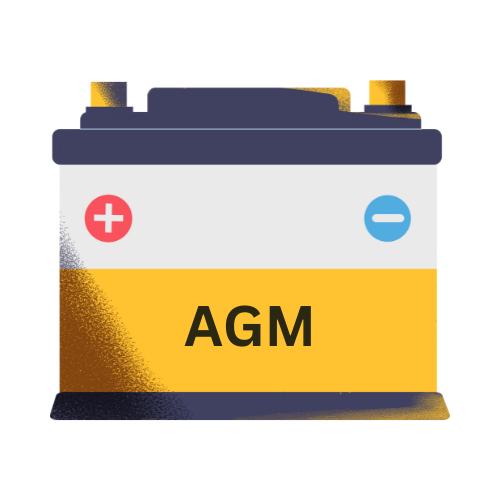
AGM (Absorbent Glass Mat) Batteries
An AGM (Absorbent Glass Mat) battery uses fiber matting to store the electrolyte. It’s a sealed battery, so it doesn’t require any maintenance.
AGM batteries have long been the standard choice for RV use (and generally still are).
What are the Advantages Of AGM Batteries?
Maintenance Free:
AGM batteries are pretty much set and forget. They require no battery management system, and because they are a sealed unit need no topping up like traditional flooded acid batteries.
High Discharge Current:
AGM batteries are excellent for equipment that requires a high initial start up current. These can include A/C units, microwave ovens, refrigerators, furnaces, power tools etc.
Lower Cost:
AGM batteries are a much lower price than LiFePO4 batteries. They are a much more budget friendly option.
Cold Weather Performance:
You can charge and discharge AGM batteries with no problems in cold weather.
What Are The Disadvantages Of AGM Batteries?
Weight:
AGM batteries are significantly heavier than lithium batteries. This can be a big disadvantage in smaller RVs or van builds.
Lifespan:
The cycle life (charge and discharge) of an AGM battery is a lot shorter than a LiFePO4 battery. An AGM battery may last 500 – 1000 cycles, a similar size LiFePO4 battery would last 2000 – 4000 cycles.
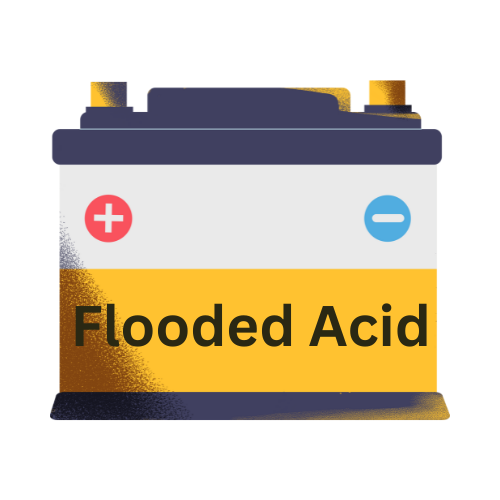
Flooded Acid
Flooded acid batteries are the oldest type of rechargeable battery there is. The flooded acid battery has been around since the mid 1800’s, and is still used today in many applications.
Due to the improvements in AGM and LiFePO4 battery technology, traditional flooded acid batteries have declined in popularity.
What Are The Advantages Of Flooded Acid Batteries?
Cost:
Flooded acid batteries are the most inexpensive RV battery available. This type of battery is also the most widely available.
What Are The Disadvantages Of Flooded Acid Batteries?
High Maintenance:
The traditional lead acid battery, while inexpensive, does need a lot of maintenance. They will need proper ventilation and regular top ups.
Common RV Battery Groups
RV batteries come in a wide range of different sizes and have different electrical capacities.
To make sense of them all, RV batteries are categorized into “groups”.
These groups are used as a standard by organizations like the BCI (Battery Council International) to make sure different brands are interchangeable.
Below are the groups most commonly used in RVs.
| Average Dimensions | Capacity | |
| Group 24 | L 10.2″ x W 6.8″ x H 8.8″ | 70 – 85 Amp Hours |
| Group 27 | L 12.0″ x W 6.6″ x H 8.8″ | 85 – 105 Amp Hours |
| Group 31 | L 13.0″ x W 6.8″ x H 9.4″ | 95 – 125 Amp Hours |
| Group 4D | L 20.7″ x W 8.7″ x H 10.0 “ | 180 – 215 Amp Hours |
| Group 8D | L 20.7″ x W 11.0″ x H10.0″ | 225 – 255 Amp Hours |
Because batteries from each battery group are approximately the same size and capacity, it’s easier to choose the correct battery for your needs.
Understanding Amp Hours And Watt Hours
Amp hours (Ah) and watt hours (Wh) can often get unnecessarily complicated.
Let’s break it down.
Amps Hours
Amps are used to measure the rate of electrical flow.
This will help you work out how much current your RV battery can supply to your equipment.
Amp hours (Ah) indicate how many amps the battery can deliver over a certain amount of time.
To work out how long a 100Ah battery will last using (X) amount of amps, just divide the amp hours by the amps.
Examples:
100Ah ÷ 12 amps = 8.3 hours
100Ah ÷ 36 amps = 2.7 hours
The higher the amp hour rating of a battery, the longer it will last before needing a recharge.
Watt Hours
Watt hours will help you work out how long equipment and devices will last in your RV.
To work out the watt hour (Wh) rating of any battery, multiply the voltage of the battery by the amp hours (Ah).
Examples:
12V x 100Ah = 1200 Watt Hours (Wh)
24V x 280Ah = 6720 Watt Hours (Wh)
Knowing your watt hour capacity will help you work out how long your battery will last, based on the total power usage of your equipment.
Working Out Your Equipment Power Consumption
Now we’ve got a handle on the amps and watt hours, we need to work out the total amount of watt hour consumption for all the devices and equipment in your RV.
This is how you do it.
First, you will need to find the wattage rating of all the devices and equipment you will use in your RV over a 24 hr period. The wattage rating of any device or appliance can usually be found on a label (normally stuck to the underneath of the device).
Next, multiply the wattage of the appliance or device by the number of hours per day that you will use it. (A decent rough estimate is good enough).
Device Watts x Hours per Day = Total Watt Hours per Day
Example:
12V TV Wattage Rating = 60W
Daily Usage = 2 Hours
60W x 2 Hours = 120 Watt Hours (Wh)
If you use a device for just a few minutes a day, here is how you work it out.
Device Watts x Minutes Per Day ÷ 60 Minutes = Total Watt Hours Per Day
Example:
Toaster Wattage Rating = 850W
Daily Usage = 12 Minutes
850W x 12 Minutes ÷ 60 Minutes = 170 W
Do this for all the devices and appliances you will use in a 24 hour period, and add them together to get a total watt hour usage for your RV.
Once you have your total watt hour consumption, you will know what your battery capacity should be to cover everything.
Here’s another great resource for helping to estimate RV equipment power consumption.
Connecting Batteries In Series and Parallel
Connecting in Series
So what does it mean to connect batteries in series?
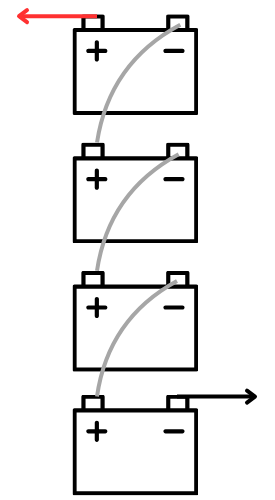
Wiring in series basically means you are wiring the positive terminal of one battery to the negative terminal of the next, and so on.
In series, the voltage of all the batteries you have connected is added together to give you a higher voltage capacity. The amp hour capacity of the connected batteries stays the same as a single battery.
For instance, if you wire four 12V 100Ah batteries in series, you’ll end up with 48V at 100Ah. This higher voltage is a must when you need to power equipment and appliances that require more voltage, or if you’ve got a bigger RV which has a 24V system.
Another advantage of having this higher voltage is that it lowers the current, which means you can use thinner wires when installing a 24V system.
Connecting In Parallel
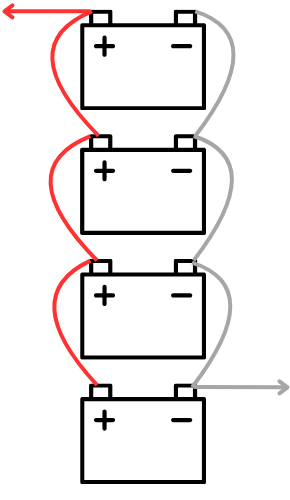
Connecting batteries in parallel is essentially the opposite of connecting in series.
Connecting in parallel means connecting all the positive terminals together and all the negative terminals together.
Doing this increases your amp hour capacity, but keeps the voltage the same as a single battery.
When you have a bigger amp hour capacity you can run your equipment and appliances for much longer.
Usable Capacity

Another thing you will have to take into account, is the usable capacity of your battery.
Usable capacity is the amount of battery power you can use before the battery needs charging.
You can damage, or shorten a battery’s lifespan if you discharge it below a certain level.
There is a big difference between the usable capacity of an AGM battery and a LiFePO4 battery.
As a general rule of thumb you shouldn’t discharge an AGM battery below about 50% before recharging.
On the other hand, you could easily discharge 90% of a LiFePO4 battery without any problems at all.
This means that a 100Ah AGM battery has a usable capacity of around about 50Ah.
A 100Ah LiFePO4 battery has a usable capacity of around 90Ah.
Depending on what kind of battery you are going to opt for, this will make a big difference in how long you can run your appliances and devices for.
Hopefully I’ve given you some insight into the benefits and disadvantages of the different types of RV deep cycle batteries.
My personal choice would be the SOK Lithium.
Please check out my other equipment reviews.
See how we rate products in my reviews here.



